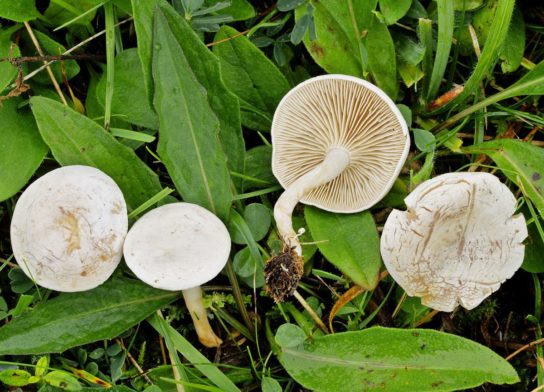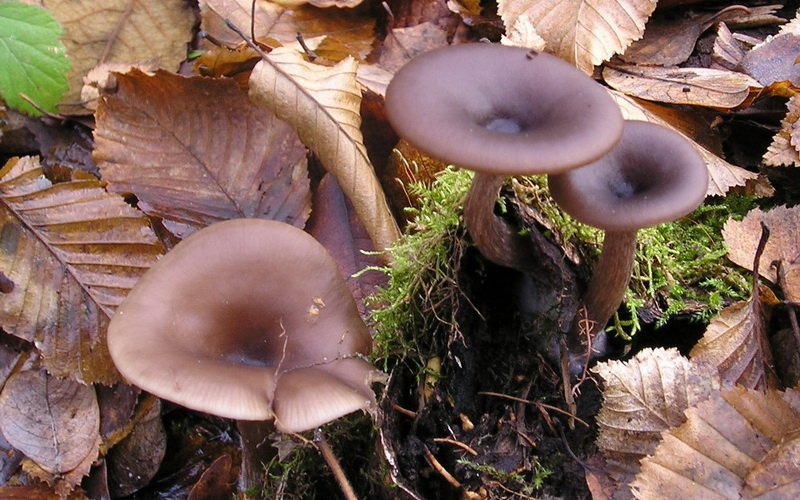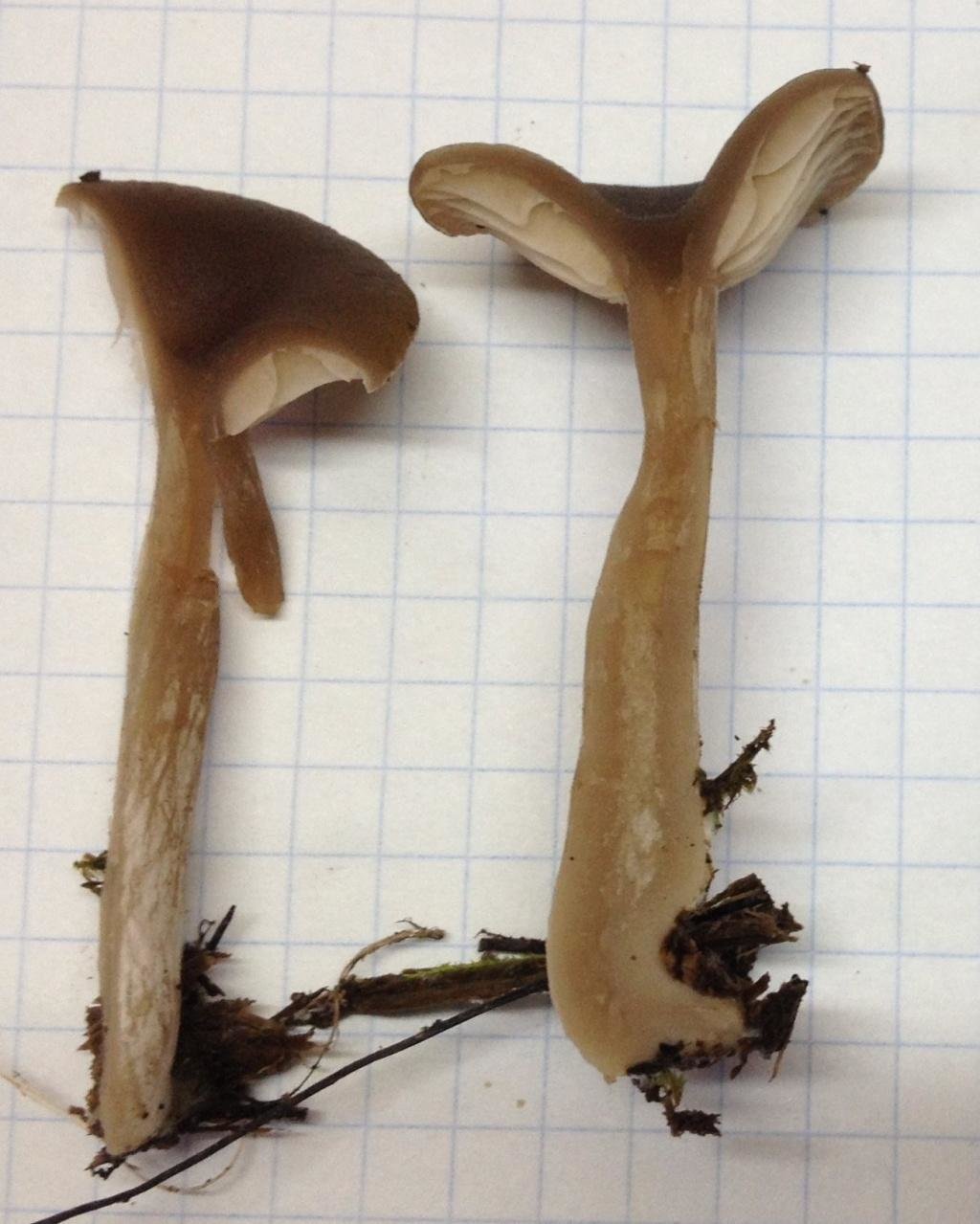Places of growth of goblet goblets.
Goblet talkers are found from the beginning of August to the end of September. They settle in mixed forests and conifers. You can find them on rotting wood and litter. Goblet talkers grow in groups or singly, rarely come across.

Evaluation of the edibility of goblet goblet.
Goblet pea is an edible but little-known mushroom. Talkers have a delicate taste and a fruity smell. The caps of young specimens are mainly used for food, since the legs are completely tasteless. Old talkers lose their aroma.

Young talkers are well suited for any traditional meal. They are used boiled, as well as pickled and salted. They give dishes a delicate flavor, so they are good in sauces and soups. It is not recommended to use them raw, as the enzymes they contain give the pulp a bitter taste.
It is worth knowing that talkers are significantly boiled down during heat treatment and lose about half of the mass.

Definitioner
- Basidia (Basidia)
-
Lat. Basidia. A specialized structure of sexual reproduction in fungi, inherent only in Basidiomycetes. Basidia are terminal (end) elements of hyphae of various shapes and sizes, on which spores develop exogenously (outside).
Basidia are diverse in structure and method of attachment to hyphae.
According to the position relative to the axis of the hypha, to which they are attached, three types of basidia are distinguished:
Apical basidia are formed from the terminal cell of the hypha and are located parallel to its axis.
Pleurobasidia are formed from lateral processes and are located perpendicular to the axis of the hypha, which continues to grow and can form new processes with basidia.
Subasidia are formed from a lateral process, turned perpendicular to the axis of the hypha, which, after the formation of one basidium, stops its growth.
Based on morphology:
Holobasidia - unicellular basidia, not divided by septa (see Fig. A, D.).
Phragmobasidia are divided by transverse or vertical septa, usually into four cells (see Fig. B, C).
By type of development:
Heterobasidia consists of two parts - hypobasidia and epibasidia developing from it, with or without partitions (see Fig. C, B) (see Fig. D).
Homobasidia is not divided into hypo- and epibasidia and in all cases is considered holobasidia (Fig. A).
Basidia is the place of karyogamy, meiosis and the formation of basidiospores. Homobasidia, as a rule, is not functionally divided, and meiosis follows karyogamy in it. However, basidia can be divided into probasidia - the site of karyogamy and metabasidia - the site of meiosis. Probasidium is often a dormant spore, for example in rust fungi. In such cases, probazidia grows with metabasidia, in which meiosis occurs and on which basidiospores are formed (see Fig. E).

See Karyogamy, Meiosis, Gifa.
- Pileipellis
-
Lat. Pileipellis, skin - differentiated surface layer of the cap of agaricoid basidiomycetes. The structure of the skin in most cases differs from the inner flesh of the cap and may have a different structure. The structural features of pileipellis are often used as diagnostic features in descriptions of fungi species.
According to their structure, they are divided into four main types: cutis, trichoderma, hymeniderma and epithelium.
See Agaricoid fungi, Basidiomycete, Cutis, Trichoderma, Gimeniderm, Epithelium.
- Ixokutis
-
Cutis, consisting of hyphae immersed in mucus. The surface of the cap is oily, slippery or slimy.
Lat. Ixocutis.
See Cutis, Gifa.
- Anastomoses (Anastomosis)
-
1) Fusion of cells of branched hyphae or germ tubes of germinating spores;
2) Connecting the plates of the fruiting bodies of the mushrooms with jumpers.
- Amyloid (Amyloid structure)
-
The structure is called amyloid if from Melzer's reagent (solution of 0.5 g of crystalline iodine + 1.5 g of potassium iodide + 20 ml of chloral hydrate + 20 ml of distilled water) turns blue, violet, sometimes almost black.
See Dextrinoid structure.
Useful properties of a talker.
Talkers are useful for the body, since they, like other mushrooms, combine vegetable and animal proteins. They are rich in minerals, fiber, amino acids and vitamins. They contain a lot of B vitamins.
Goblet talkers have a positive effect on the digestive system, protect immunity, and even reduce the risk of developing malignant tumors.
Talkers are low in calories, therefore they are recommended for dietary meals. They cleanse and improve the work of the whole body, as they remove salts and toxins from it. In terms of the amount of nutrients, they are similar to meat, therefore they are indispensable for vegetarians. These mushrooms normalize blood cholesterol levels and reduce the risk of blood clots.

People have figured out the benefits of talkers for a long time. In folk medicine, decoctions, extracts and ointments from talkers are used, which have a disinfecting effect, heal wounds and help with urolithiasis and respiratory diseases.
The similarity of the goblet goblet with other species.
The goblet goblet has an external resemblance to the funnel-shaped govorushka. This species is also edible. The cap of the funnel-shaped talker is first convex, and then becomes goblet or funnel-shaped. Its color is fawn, leathery or gray-yellow. The pulp is thin, dry, white in color. She has a peculiar smell. The leg is lateral, solid, slightly lighter than the cap, often fluffy at the base.

Funnel talkers bear fruit from July to September. They grow in forests, in groups, along paths and roads. These mushrooms settle in the litter, shallow.
Description of goblet goblet.
The cap is cup-shaped or deep-funnel-shaped with curved, uneven edges. The diameter of the bowl is 4-8 centimeters. Its surface is silky in dry weather, and becomes hygrophane in damp weather. The color of the cap is gray-brown.

The platelets of the goblet goblet are rare, descending. The color of the plates is light brown or grayish. Spore white powder. The pulp is watery, thin. The color of the pulp is gray-brown.
The leg is long and thin - 4-7 centimeters long, and no more than 0.5 centimeters in girth. The base of the pedicle is pubescent. In color, it is close to the hat or slightly lighter.

Why is this necessary?
In a nutshell: just like that. Why pick mushrooms? It's easier to buy. But we collect. Why do you need to photograph mushrooms if the Internet is full of photos? But we take pictures. Why try to identify every mushroom you meet with the exact same species? Yes, for the collection!
I am sincerely saddened when, at the height of the season, someone dumps a photo of assorted mushrooms on the forum and asks: "can you eat this?" (Yes, exactly "eat", I insist on the absolute inevitability of this verb in this context.) What can I say? Yes, you will not say anything. No normal person will take responsibility for determining the edibility of a mushroom from a few bad photographs.
There are at least one kind of mushrooms here (photo by user kunash)
First of all, mushrooms are determined for scientific and educational purposes. Simply put, for the purpose of collecting. Man is a drug addict by nature; the release of endogenous stimulants in exchange for a successful solution to the next task covers more than a whole meadow of boletus. Over time, of course; but many sit down, changing the basket for a camera and a notebook. Finding and clearly identifying a new mushroom for yourself is a great joy; and the wider the collection, the more joyful the replenishment.
Although this does not exclude the option of “eating”. It is curious that I, it seems, have never identified for myself mushrooms with gastronomic motives. Is that in early childhood, when I first saw luxurious shaggy dung beetles on the way to school ...
How it's done?
Mushrooms can be identified by two methods: digital and analog. They, of course, do not contradict each other, but on the contrary.I, like the overwhelming majority of the humanities with a low culture of thinking, rely entirely on the second. Sometimes this leads to sad results - this is, in fact, the beginning of the article.
- An analog way of defining a mushroom: "I recently saw someone like that." A very simple, affordable method for everyone who likes to look through the pages of the mushroom forum at their leisure. People are actively, or even persistently, sharing their finds - just be aware of it. Unfortunately, often the feeling: “recently met this” results in a long boring search, as a result of which it turns out that “recently” is three years, and the mushroom is completely wrong ...
- The digital method for determining the fungus, based on the isolation of certain features, is used where analog does not pull. They should not oppose each other, so that it does not work out as with those mycologists in the Voronezh region. Going out "in the field", they easily took those mushrooms that a person does not even suspect about, but they had a complete embarrassment in identifying ordinary milkmen and ryadovki. A simple mushroom picker, who does not even know "penis canina" in Latin, easily overtook them simply due to his rich experience. Although he owns digitally. Simply - what's the point of laying out the aspen milk mushrooms on the basis of signs?
We will not define the mushroom veselka in an analogous way - it does not look like that ... (photo by I. Lebedinsky)
But hereinafter, we will talk exclusively about the second, scientific method for determining fungi. About the one that I repeatedly neglect in favor of the lazy, analogue, than I put myself in a false position against the background of real amateur mycologists.
Examples that inspire us
Ivishen, or sub-cherry, orchard (Clitopilus prunulus). This trivial mushroom I could not identify for more than two seasons - simply because I did not apply a "digital approach" to it. The trouble is that the mushroom looks very much like a talker - I was looking for it in the wide genus Clitocybe until I figured out the key sign: the color of the spore powder. It turned out to be pink, whereas for the talkers it was strictly white. Then it was easy.
Controversial "semi-white". They are rare with us, hence the hardships (photo by I. Lebedinsky)
Semi-white mushroom (Boletus impolitus). Here the story is different. The digital method was applied, decomposed according to features. According to all the data, there are only two similar mushrooms in the Tula region. Semi-white - does not turn blue on the cut, but it smells like carbolic acid. Boletus girlish, on the contrary, does not smell bad, but turns blue. Mine did not turn blue or smelled, which plunged me into cognitive dissonance. Spas, as usual, is a case. Usually I collected semi-white in hot and dry weather, and July 2019 turned out to be cold and wet. And the same mushrooms, from the same place, smacked with hospital rags so that at least lie down and die! It turns out that the sign is unstable. And this, by the way, was in all the descriptions. Blue is a persistent sign, smell is not. And why not read the description before and not after? ..










































